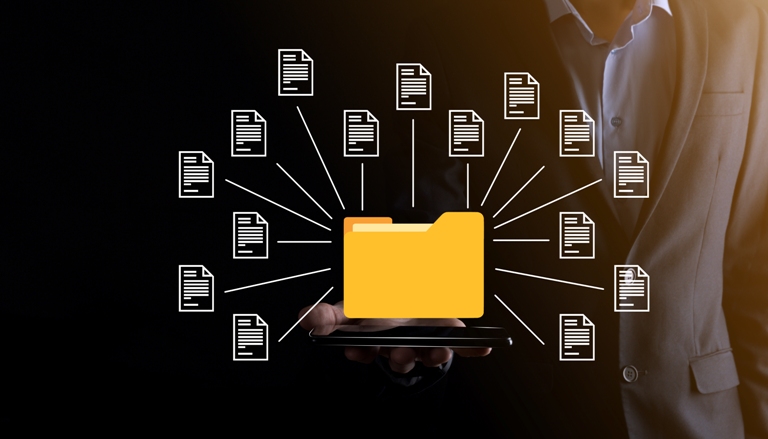
If you’re looking for a more effective and efficient way to manage company documents while staying compliant with regulations in security-sensitive industries such as healthcare, finance, insurance, or IT, the right enterprise document management system could be the answer.
In today’s digital-first world, businesses are inundated with information. From contracts and invoices to employee records and customer communications, the sheer volume of documents generated on a daily basis is staggering. Managing all this information efficiently is no longer optional—it’s essential. Enter the enterprise document management system (EDMS), a transformative solution that empowers the diverse organizations to streamline the operations, boost collaboration, and also ensure complete compliance in a highly complicated regulatory landscape.
What Is an Enterprise Document Management System?
An enterprise document management system or EDMS is a centralized platform designed in detail to capture, store, organize, retrieve, and manage digital documents across an organization. Unlike traditional file storage systems, an EDMS offers advanced features like version control, access permissions, workflow automation, and audit trails. These capabilities make it a vital tool for businesses aiming to reduce paper dependency, improve productivity, and maintain data integrity.
Why Businesses Need an EDMS?
The need for an enterprise document management system stems from several pressing challenges:
1. Information Overload: As businesses grow, so does the volume of documents. Without a structured system, locating the right file becomes time-consuming and error-prone.
2. Compliance Requirements: Industries like healthcare, finance, and legal services are subject to the strict regulations regarding data retention as well as privacy. An EDMS helps to ensure complete compliance by maintaining secure, and traceable records.
3. Remote Work and Collaboration: With distributed teams becoming the norm, employees require easy access to documents from anywhere. An EDMS facilitates a real-time collaboration and document sharing.
4. Security Concerns: Data breaches and unauthorized access can have severe consequences. Enterprise document management systems offer very robust security features like encryption, role-based access, and audit logs.
Key Features of an Enterprise Document Management System
A well-designed EDMS offers a suite of features tailored to meet the diverse needs of the modern enterprises:
1. Centralized Repository: All documents are stored in a single, searchable location, eliminating the chaos of scattered files across the email, desktops, and cloud drives.
2. Version Control: Track the changes and maintain a complete history of the document revisions. This ensures that teams are always working with the latest information.
3. Access Control and Permissions: Administrators can clearly define who can view, edit, or delete all the documents, ensuring highly sensitive information is only accessible to authorized personnel.
4. Workflow Automation: Automate routine tasks like document approvals, notifications, and routing. This reduces manual effort and accelerates business processes.
5. Search and Retrieval: Advanced search capabilities— using metadata, keywords, or full-text search—allow users to locate documents quickly and accurately.
6. Integration with Other Systems: Modern EDMS platforms integrate with CRM, ERP, and HR systems, enabling seamless data exchange and reducing duplication of effort.
7. Audit Trails and Compliance: Every action taken on a document is logged, providing a transparent audit trail that supports the regulatory compliance and internal governance.
8. Mobile and Remote Access: With mobile apps and cloud-based access, employees can retrieve and manage documents from anywhere, enhancing flexibility and responsiveness.
Also Read: Document Management System for Enterprises
Benefits of Implementing an EDMS
The adoption of an enterprise document management system yields tangible benefits across the organization:
1. Enhanced Productivity: Employees spend very less time searching for documents and more time on the value-added tasks. Automated workflows further streamline operations.
2. Improved Collaboration: Teams can collaborate on all documents in real time, regardless of location. Version control ensures consistency and reduces confusion.
3. Cost Savings: Reducing the uasge of paper, printing, and physical storage leads to very significant cost savings. Additionally, automation minimizes labor-intensive tasks.
4. Better Decision-Making: With instant access to accurate, up-to-date information, decision-makers can respond faster and more effectively to business challenges.
5. Stronger Security: Data encryption, access controls, and very secure backups protect highly sensitive information from unauthorized access and loss.
6. Environmental Impact: Going paperless reduces the organization’s carbon footprint and supports sustainability initiatives.
Use Cases Across Industries
The versatility of enterprise document management systems makes them valuable across an extensive range of industries:
Healthcare: Manage the patient records, insurance forms, and compliance documentation safely and efficiently.
Legal: Organize case files, contracts as well as court documents with version control and audit trails.
Finance: Streamline loan processing, account management as well as regulatory reporting.
Manufacturing: Maintain product specifications, quality control records, and supplier documentation.
Education: Store student records, administrative documents, and curriculum materials in a centralized system.
Government: Ensure complete transparency, accountability, and secure access to the public records and internal documentation.
Implementation Strategy: How to Get Started
Implementing an enterprise document management system requires a very strategic approach:
1. Assess Your Needs: Identify the different types of documents you manage, the departments involved, and the pain points in your current system.
2. Define Objectives: Set clear goals for what you want to achieve—whether it’s improving compliance, reducing costs, or enhancing collaboration.
3. Choose the Right Vendor: Evaluate EDMS providers based on features, scalability, user experience, support, and compliance capabilities.
4. Plan the Rollout: Develop a phased implementation plan, beginning with a pilot program in one department before scaling organization-wide.
5. Train Your Team: Provide comprehensive training to ensure that all the users understand how to use the system effectively and securely.
6. Monitor and Optimize: Continuously monitor system performance, gather user feedback, and make adjustments to improve efficiency and adoption.
Common Challenges and How to Overcome Them
While the benefits are substantial, organizations may have to face challenges during implementation:
1. Resistance to Change: Employees may be very hesitant to adopt the new systems. Address this with clear communication, training, and demonstrating value.
2. Data Migration: Moving documents from legacy systems can be complex. Work with vendors to ensure a very smooth transition.
3. Customization Needs: Off-the-shelf solutions may not fit every workflow. Choose a system that allows for customization and integration.
Future Trends in Document Management
As technology evolves, so does the landscape of document management too. Here are some emerging trends shaping the future of EDMS:
1. Artificial Intelligence and Machine Learning: AI-powered systems can automatically categorize the documents, extract key data, and even detect anomalies. This reduces manual input and enhances accuracy.
2. Cloud-Based Solutions: Cloud-based EDMS platforms offer flexibility, scalability, and remote access, making them ideal for hybrid and remote work environments.
3. Mobile Accessibility: With mobile apps, employees can access and manage documents on the go, increasing responsiveness and agility.
4. Blockchain for Document Integrity: Blockchain technology is being explored to ensure document authenticity and prevent tampering, especially in legal and financial sectors.
5. Predictive Analytics: Advanced analytics can provide insights into the document usage patterns, helping organizations to optimize the workflows and resource allocation.
In Conclusion:
In an era where information is both a strategic asset as well as a potential liability, the crucial importance of an enterprise document management system cannot be overstated. By centralizing the process of document storage, automating workflows, and enhancing security, an EDMS empowers the organizations to operate more efficiently, collaborate more effectively, and also stay compliant with the industry regulations.
Whether you are a small business scaling up or a multinational enterprise optimizing the operations, investing in a robust enterprise document management system is a very strategic move that pays dividends in productivity, security, and peace of mind.
If you’d like to have an in-depth look at SFT Dox’s enterprise content management system, get a FREE DEMO today!








